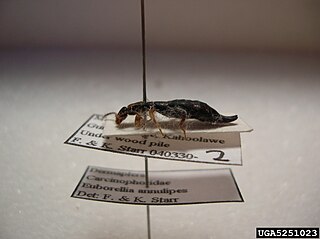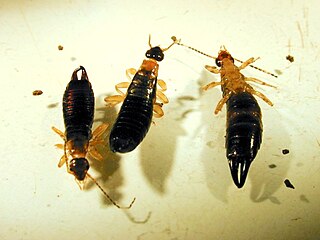Related Research Articles

Earwigs make up the insect order Dermaptera. With about 2,000 species in 12 families, they are one of the smaller insect orders. Earwigs have characteristic cerci, a pair of forceps-like pincers on their abdomen, and membranous wings folded underneath short, rarely used forewings, hence the scientific order name, "skin wings." Some groups are tiny parasites on mammals and lack the typical pincers. Earwigs are found on all continents except Antarctica.

Forficulidae is a family of earwigs in the order Dermaptera. There are more than 70 genera and 490 described species in Forficulidae.
Paratachardina pseudolobata, the lobate lac scale, is a polyphagous and pestiferous lac scale insect, which damages trees and woody shrubs in Cuba, Florida, the Bahamas and the Australian territory of Christmas Island. It was mistakenly identified as Paratachardina lobata (Chamberlin), an insect native to India and Sri Lanka, but was in 2007 recognized and named as a distinct species based on material from Florida; its native distribution is as yet unknown. The new lac insect was described based on all stages of the female, during the revision of the genus Paratachardina, wherein all its known species were redescribed.

Anisolabididae is a family of earwigs, in the suborder Forficulina and the order Dermaptera. It is one of nine families in the suborder Forficulina, and contains thirty-eight genera spread across thirteen subfamilies.

Euborellia is a genus of earwigs in the subfamily Anisolabidinae. It was cited by Srivastava in Part 2 of Fauna of India. Euborellia are small, dark-colored earwigs. Species can be difficult to distinguish from one another. There are about 50 species.
Euborellia ambigua is a species of earwig in the family Anisolabididae.

The ringlegged earwig is a species of earwig in the family Anisolabididae.
Euborellia aporonoma is a species of earwig in the family Anisolabididae.
Euborellia caraibea is a species of earwig in the family Anisolabididae.
Euborellia cincticollis is a species of earwig in the family Anisolabididae.
Euborellia eteronoma is a species of earwig in the family Anisolabididae.
Euborellia femoralis is a species of earwig in the family Anisolabididae.
Euborellia stali is a species of earwig in the family Anisolabididae.
Euborellia moesta is a species of earwig in the family Anisolabididae.
Anisolabis mauiensis is a species of earwig in the genus Anisolabis, the family Anisolabididae, the suborder Forficulina, and the order Dermaptera.
Ischnodemus variegatus is a species of insect in the order of true bugs known by the common name myakka bug. It is native to Central and South America. It is also known as an introduced species in Florida in the United States.

Tessaratomidae is a family of true bugs. It contains about 240 species of large bugs divided into 3 subfamilies and 56 genera.

The spotted lanternfly is a planthopper that is indigenous to parts of Southern China, Taiwan, and Vietnam, and has spread invasively to Japan, South Korea, and the United States. Although it has two pairs of wings, it jumps more than it flies. Its host plants include grapes, stone fruits, and Malus species, although its preferred host is Ailanthus altissima. In its native habitat it is kept in check by natural predators or pathogens. It was accidentally introduced in South Korea in 2006 and has since been considered a pest. In September 2014, it was first recorded in the United States, and as of 2020 it is an invasive species in the Delaware Valley, northern Delaware, eastern Maryland, eastern Pennsylvania, southwestern New Jersey, New York, Connecticut, northern Virginia, and Ohio.
Saissetia coffeae, known generally as hemispherical scale, is a species of soft scale insect in the family Coccidae. Other common names include the helmet scale and coffee brown scale.
Aspidiotus destructor, the coconut scale, is a species of armoured scale insect in the family Diaspididae, found in many tropical and subtropical parts of the world. It is a serious pest of coconut and banana, and attacks a range of other fruiting trees and ornamental plants.
References
- ↑ "ITIS Standard Report Page: Euborellia". Integrated Taxonomic Information System. Retrieved 7 July 2009.
- ↑ "ITIS Standard Report Page: Euborellia plebeja". Integrated Taxonomic Information System. Retrieved 7 July 2009.
- ↑ "CTD: Euborellia". The Comparative Toxicogenomics Database. Retrieved 7 July 2009.
- ↑ "CTD: Euborellia plebeja". The Comparative Toxicogenomics Database. Retrieved 7 July 2009.
- ↑ "Euborellia plebeja". Zipcode Zoo. Retrieved 7 July 2009.
- ↑ Baijal HN (1974). "Notes on the biology of Euboriella plebeja". Indian Journal of Entomology (1): 23–27.
- ↑ Hebard M. (1927). "Studies in Dumatran Dermaptera". Proceedings of the Academy of Natural Sciences of Philadelphia. 79: 23–48.
- ↑ Borelli A. (1928). "Dermaptera In: Insects of Samoa and other Samoan terrestrial Arthropoda. Part 1. Orthoptera and Dermaptera". FASC. 1: 1–8.
- ↑ Rehn JAG. (1949). "Dermaptera records from Guam". Transactions of the American Entomological Society. 75: 109–11.
- ↑ Brindle A. (1966). "Dermaptera of Madagascar". Transactions of the Royal Entomological Society of London. 118 (7): 221–59. doi:10.1111/j.1365-2311.1966.tb02305.x.
- ↑ Kim C-W, Moon T-Y. (1985). "A taxonomic revision of Korean Dermaptera". Entomological Research Bulletin. 11: 37–60.
- ↑ Haas F. (1995). "New records of Dermaptera from India and South America, with notes on their ecology, and a description of an unknown female". Entomologist. 114 (3–4): 153–57.
| This earwig-related article is a stub. You can help Wikipedia by expanding it. |